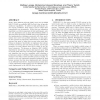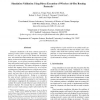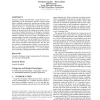3257 search results - page 616 / 652 » networking 2004 |
107
Voted
MSWIM
2004
ACM
15 years 6 months ago
2004
ACM
Today, three different physical (PHY) layers for the IEEE 802.11 WLAN are available (802.11a/b/g); they all provide multi-rate capabilities. To achieve a high performance under v...
PADS
2004
ACM
15 years 6 months ago
2004
ACM
Computer simulation is the most common approach to studying wireless ad-hoc routing algorithms. The results, however, are only as good as the models the simulation uses. One shoul...
113
click to vote
PODC
2004
ACM
15 years 6 months ago
2004
ACM
Group key exchange protocols allow a group of servers communicating over an asynchronous network of point-to-point links to establish a common key, such that an adversary which fu...
118
click to vote
SIGCOMM
2004
ACM
15 years 6 months ago
2004
ACM
All Internet routers contain buffers to hold packets during times of congestion. Today, the size of the buffers is determined by the dynamics of TCP’s congestion control algor...
119
click to vote
SIGCOMM
2004
ACM
15 years 6 months ago
2004
ACM
While application end-point architectures have proven to be viable solutions for large-scale distributed applications such as distributed computing and file-sharing, there is lit...



